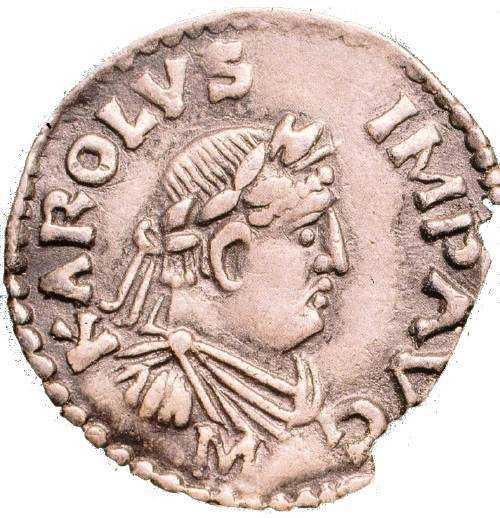Back in 1999 Chris Dickinson posted a fine piece of Internet performance art to the Usenet discussion list soc.genealogy.medieval. Beginning with the sentence “We are all descended from Charlemagne,” he funneled it through Babelfish dozens of times, bouncing among the various Western European languages. By the twenty-seventh line the sentence was twisted strangely:
This bit of nonsense masks the value of the original hypothesis, which is almost certainly true: we are all descended from Charlemagne—at least, all of us with any European descent at all.

It is difficult to trace the history of this assertion, though it is certainly similar to Horace Round’s exaggerated claim (around one hundred years ago) that he could trace any Englishman—of any social class—back to King Edward III.
Mark Humphrys, a computer scientist in Dublin, has made a point of comparing various schemes to predict the recent common ancestors of all living people. His webpages on the ‘common ancestor’ question provide a fascinating survey of genealogical, genetic and statistical approaches.
In 1999 Joseph Chang, a statistician at Yale University, wrote a mathematical formula to predict how far back we would have to go to find someone who was the ancestor of every person alive today. While his model was rather abstract (he assumed that ANY two people could have a child, not just a man and a woman), his conclusion was surprisingly short: we would only need to go back to about 1200 AD.
More recently (2002 and 2003), a sophisticated model by MIT computer scientist Douglas Rohde has taken into account such factors as geographic isolation and non-random mate choice. Rohde’s model resulted in a more conservative but still surprisingly short estimate, that the most recent common ancestor of all living people lived as recently as 300 AD. A more sophisticated iteration of Rohde’s computer model is currently (2004) under construction and testing. These studies offer a thought-provoking counterpoint to the research into common male-line and female-line genetic inheritance (the ‘mitochondrial Eve’ and ‘DNA Adam’ phenomena) which predicts vastly greater time to common ancestors if one follows only the exclusively male or exclusive female lines of descent.
As a medievalist, I am heartened that these scientists have been offering support for something that comes as a gut reaction to many genealogists who have traced premodern lines: everyone does seem to descend from Charlemagne. One website points out the obvious arithmetical issue: if we were to go back to Charlemagne, say 40 generations, we would have just over one trillion ancestors in that generation, far more than the number of people who have ever lived, let alone the number of people in the world then, which may have been about fifty million. This simplistic argument, despite its limitations, makes it easy to understand that the probability that someone like Charlemagne, who we know had descendants, is *not* our ancestor is essentially zero.
But why Charlemagne? It is not without some reason that Charlemagne comes up so often as a symbolic ancestor—the “Father of Europe.” Living from 747 (or 748) to 814, he was the first Germanic king of the Middle Ages to reassemble a large portion of the defunct Western Roman Empire under his personal rule, which stretched into what is now Spain, France, Italy, Switzerland, the Low Countries, Austria, and Germany. Aside from being named ‘Emperor’ (actually, ‘Augustus’) by a grateful Roman papacy in the year 800, he more importantly instituted many features of a successful medieval government, and spread that model throughout Western Europe, sowing the seeds for the development of several later nations. Yet his empire did not last beyond the civil wars between his grandsons, thirty years after his death in 814. One interesting point is that the collapse of Charlemagne’s empire through a combination of infighting and opportunistic invasions (by the Vikings, among others), actually insured that his own descendants spread throughout the European population: rather than remaining as a self-contained imperial aristocracy, his descendants were dispersed and then isolated from one another in the relative political vacuum of the tenth century. By this time they were spread everywhere in Western Europe and the British Isles. Subsequently their own descendants spread and married into Scandinavia and Slavic Europe, and finally to Greece and the Middle East during the Crusades.
Of the various studies of Charlemagne’s descendants in print, one conservative and scholarly overview shows eight generations of descendants, down to the year 1000 (Karl Ferdinand Werner, “Die Nachkommen Karls des Grossen bis um das Jahre 1000,” in Karl der Grosse: Lebenswerk und Nachleben, Düsseldorf, 1965-68, 4:403-82). Charlemagne did not have as many immediate descendants (say, in three generations) as some medieval monarchs: but he is surely the earliest such figure for whom such a broad descendancy has been so thoroughly traced. If he is not what, in Rohde’s model, is identified as the ‘most recent common ancestor’ (that is, the first person, working backwards, who is the ancestor of all living individuals), by virtue of his position he may well serve as a proxy for such an individual, thus in a biological as well as political sense ‘the Father of Europe’.

3 Trackbacks/Pingbacks
[…] a great explanation on this blog over here: https://nltaylor.net/sketchbook/archives/9 and this guy did the […]
[…] a great explanation on this blog over here: https://nltaylor.net/sketchbook/archives/9 and this guy did the math: http://www.gly.uga.edu/railsback/GenealComp1.html Comments […]
[…] mean 40th great grandpa (that’s “great-great-great-great-great”…and so on 40 times!) And by “everyone’s” I actually mean merely the ancestor of 90% of Europeans and 70% of […]
Post a Comment